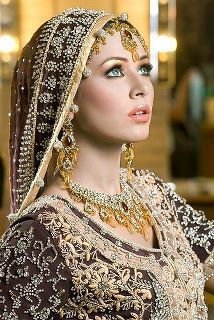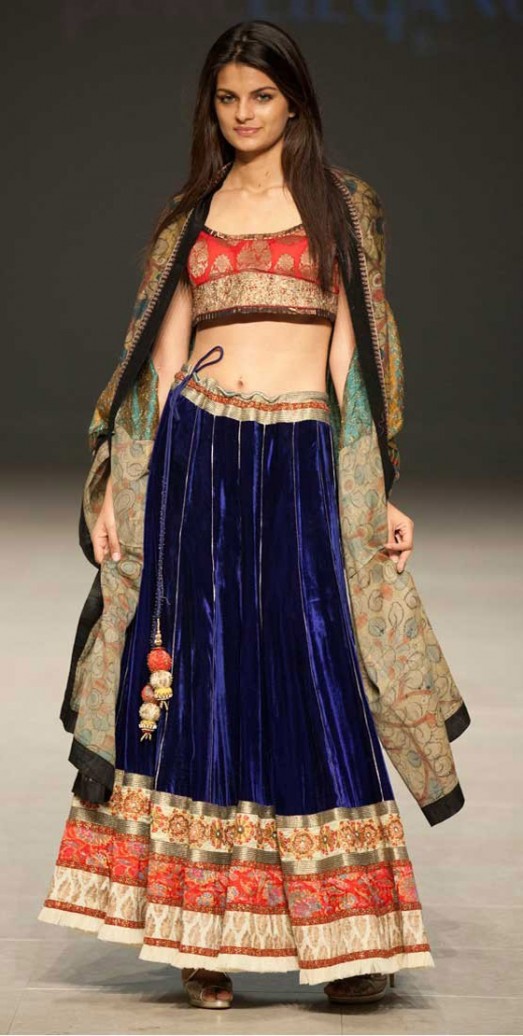Bridal Dresses Pakistani Dresses Suits Mehndi Designs Pic Jewellery Mehndi Lehengas 2013
Source:google.com.pk
Muslim Wedding
:: Pre Wedding
Mangni
The prospective bride and groom exchange rings during the mangni or engagement ceremony. The bride-to-be wears an outfit gifted to her by her future in-laws. A convenient date for the wedding or the Nikaah is fixed after the mangni.
Mehndi
The Mehndi (henna) ceremony is held at the home of the bride-to-be on the eve of the wedding ceremony or a couple of days before it.
The female relatives of the girl anoint her with turmeric paste. A relative or a mehndiwali (henna artist) applies mehndi on the hands and feet of the bride-to-be, in thin artistic patterns. The mehndi is traditionally kept overnight to obtain a dark hue.
The event has a festive feel to it with the women singing traditional songs.
:: Wedding
Baraat
The groom arrives at the wedding venue with his baraat (wedding procession). A band of musicians strikes up some traditional notes to announce their arrival.
The groom shares a drink of sherbet with the bride's brother. The bride's sisters play pranks and slap the guests playfully with batons made of flowers.
Nikaah
The Nikaah or wedding ceremony can be conducted at the home of the bride or the groom, or at any other convenient venue. A Maulvi (priest) conducts the ceremony in the presence of close family members and relatives. The 'Walis' (the father of the bride and of the groom) play an important role in the ceremony. The Maulvi reads selected verses from the Quran. The Nikaah is complete after the Ijab-e-Qubul. (proposal and acceptance). Usually, the boy's side proposes and the girl's side conveys her assent. The mutual consent of the bride and groom is of great importance for the marriage to be legal. Neither of them must be forced to enter into the marital contract. It is on the day of the Nikaah that the elder members of the two families decide the amount of Mehar (nuptial gift that is a compulsory amount of money to be given by the groom's family to the bride's.)
Nikaahnama
The Nikaahnaama is a document in which the marriage contract is registered. It contains a set of terms and conditions that must be respected by both the parties. It also gives the bride the right to divorce her husband. For the contract to be legal, it must be signed by the bridegroom, the bride, the Walis, and the Maulvi.
Blessing the groom
The groom receives blessings from the older women and offers them his salaam. The guests pray for the newly-weds.
:: Post Wedding
Rukshat
The bride's family bids her a tearful farewell before she departs for her husband's house. The bride's father gives her hand to her husband and tells him to protect and take good care of her.
Welcoming the bride
The groom's mother holds the Quran above the head of her new daughter-in-law as she enters her new home for the first time after the wedding.
Valimah
The Valimah is the lavish reception that the groom's family hosts after the Nikaah. It is a joyous occasion that brings together the two families, their relatives and other well-wishers.
The history behind the bride's and groom's attendants is 2 fold: companionship and to ward off evil spirits (and/or to confuse other suitors). In the time of the Romans there was a belief in evil spirits and bad luck that could afflict the bride and groom, so the bridesmaids and groomsmen dressed similarly to the bride and groom to confuse evil spirits. Preventing bad luck on either of them ensured a happy marriage.
The groomsmen wore similar outfits to the groom for the same reason. An easily identified groom, meant imminent bad luck.
Even prior to Roman time, suitors would pursue the traveling bride to her fiance's home. However, with attendants dressed similarly to the bride, suitors were easily confused and therefore bridesmaids prevented the bride from being captured by another man.
Today we carry on this tradition, and then some, whether we believe in evil spirits or not! However, this tradition is and has been slowly evolving for centuries, that is: from similar to different. Today, brides enjoy adding more color to their wedding scene-scape by having their bridesmaids dress in lavish colors and thereby explicitly differentiating between the bride and her attendants.
Groomsmen have held truest to the tradition, even most likely unbeknownst to them!
So if a bride really wants to have a truly "traditional" wedding, she should dress her bridesmaids in white. Perhaps they could be different styles to allow for some recognition of the individuality of each of her friends. A colored sash could add a color splash to the scene-scape, or some lusciously-colored bouquets!
I believe in the beauty of having each bridesmaid wear a different style for several reasons. If you're a bride who is worried about your bridesmaids resenting you for making them wear a bride-mandated dress, you can rest easy if you choose to let them pick out a style in a color you've chosen. This way, too, you know they'll be happy to wear it again! Allowing your friends to choose a style that suits them ensures they'll each look pristine in their dress (which ensures you have pristine photos!), and that they'll appreciate you understanding and recognizing their individuality. Plus, it still highlights you as the bride! Of course, this is not the only or best way to go, but it is a unique option that few brides choose. But if you're worried about evil spirits, you now know how to deceive them and guarantee yourselves a blessed marriage!










No comments:
Post a Comment